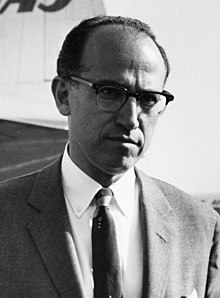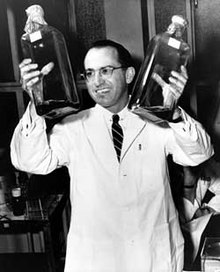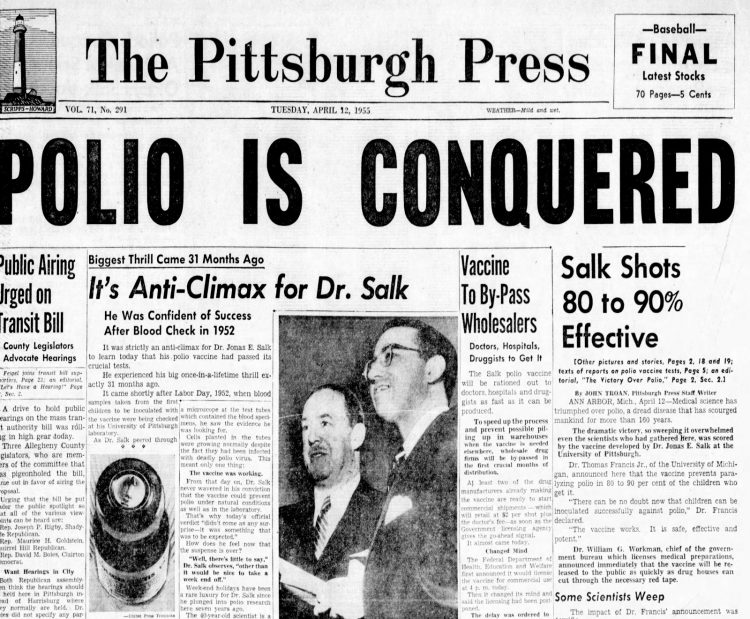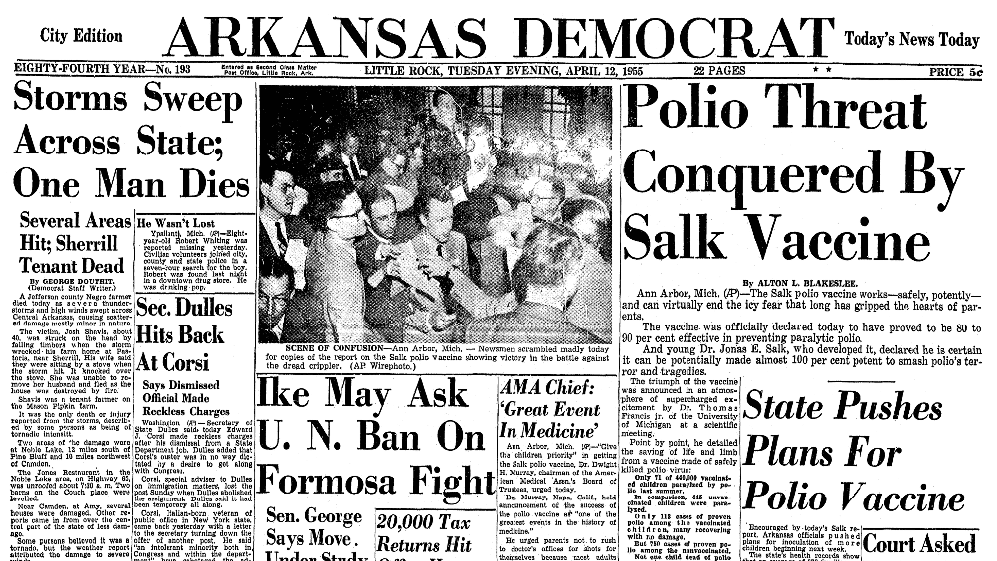Welcome to DU!
The truly grassroots left-of-center political community where regular people, not algorithms, drive the discussions and set the standards.
Join the community:
Create a free account
Support DU (and get rid of ads!):
Become a Star Member
Latest Breaking News
Editorials & Other Articles
General Discussion
The DU Lounge
All Forums
Issue Forums
Culture Forums
Alliance Forums
Region Forums
Support Forums
Help & Search
American History
Related: About this forumOn this day, April 12, 1955, it was announced that the polio vaccine Jonas Salk developed was safe.
Jonas Salk

Salk in 1959
{snip}
Polio research
Further information: Polio and Polio vaccine

President Franklin D. Roosevelt meeting with Basil O'Connor

Salk in 1955 at the University of Pittsburgh

Magazine photo of Salk to O'Neill, "the most elaborate program of its kind in history, involving 20,000 physicians and public health officers, 64,000 school personnel, and 220,000 volunteers," with over 1.8 million school children participating in the trial. A 1954 Gallup poll showed that more Americans knew about the polio field trials than could give the full name of the President.

A March of Dimes poster, c. 1957
In 1947, Salk became ambitious for his own lab and was granted one at the University of Pittsburgh School of Medicine, but the lab was smaller than he had hoped and he found the rules imposed by the university restrictive.
In 1948, Harry Weaver, the director of research at the National Foundation for Infantile Paralysis, contacted Salk. He asked Salk to find out if there were more types of polio than the three then known, offering additional space, equipment and researchers. For the first year he gathered supplies and researchers including Julius Youngner, Byron Bennett, L. James Lewis, and secretary Lorraine Friedman joined Salk's team, as well. As time went on, Salk began securing grants from the Mellon family and was able to build a working virology laboratory. He later joined the National Foundation for Infantile Paralysis's polio project established by President Franklin D. Roosevelt.
Extensive publicity and fear of polio led to much increased funding, $67 million by 1955, but research continued on dangerous live vaccines. Salk decided to use the safer 'killed' virus, instead of weakened forms of strains of polio viruses like the ones used contemporaneously by Albert Sabin, who was developing an oral vaccine.
After successful tests on laboratory animals, on July 2, 1952, assisted by the staff at the D.T. Watson Home for Crippled Children, which is now the Watson Institute for International and Public Affairs in Providence, Rhode Island, Salk injected 43 children with his killed-virus vaccine. A few weeks later, Salk injected children at the Polk State School for the Retarded and Feeble-minded. He vaccinated his own children in 1953. In 1954 he tested the vaccine on about one million children, known as the polio pioneers. The vaccine was announced as safe on April 12, 1955.
The project became large, involving 100 million contributors to the March of Dimes, and 7 million volunteers. The foundation allowed itself to go into debt to finance the final research required to develop the Salk vaccine. Salk worked incessantly for two-and-a-half years.
Salk's inactivated polio vaccine came into use in 1955. It is on the World Health Organization's List of Essential Medicines.
{snip}

Salk in 1959
{snip}
Polio research
Further information: Polio and Polio vaccine

President Franklin D. Roosevelt meeting with Basil O'Connor

Salk in 1955 at the University of Pittsburgh

Magazine photo of Salk to O'Neill, "the most elaborate program of its kind in history, involving 20,000 physicians and public health officers, 64,000 school personnel, and 220,000 volunteers," with over 1.8 million school children participating in the trial. A 1954 Gallup poll showed that more Americans knew about the polio field trials than could give the full name of the President.

A March of Dimes poster, c. 1957
In 1947, Salk became ambitious for his own lab and was granted one at the University of Pittsburgh School of Medicine, but the lab was smaller than he had hoped and he found the rules imposed by the university restrictive.
In 1948, Harry Weaver, the director of research at the National Foundation for Infantile Paralysis, contacted Salk. He asked Salk to find out if there were more types of polio than the three then known, offering additional space, equipment and researchers. For the first year he gathered supplies and researchers including Julius Youngner, Byron Bennett, L. James Lewis, and secretary Lorraine Friedman joined Salk's team, as well. As time went on, Salk began securing grants from the Mellon family and was able to build a working virology laboratory. He later joined the National Foundation for Infantile Paralysis's polio project established by President Franklin D. Roosevelt.
Extensive publicity and fear of polio led to much increased funding, $67 million by 1955, but research continued on dangerous live vaccines. Salk decided to use the safer 'killed' virus, instead of weakened forms of strains of polio viruses like the ones used contemporaneously by Albert Sabin, who was developing an oral vaccine.
After successful tests on laboratory animals, on July 2, 1952, assisted by the staff at the D.T. Watson Home for Crippled Children, which is now the Watson Institute for International and Public Affairs in Providence, Rhode Island, Salk injected 43 children with his killed-virus vaccine. A few weeks later, Salk injected children at the Polk State School for the Retarded and Feeble-minded. He vaccinated his own children in 1953. In 1954 he tested the vaccine on about one million children, known as the polio pioneers. The vaccine was announced as safe on April 12, 1955.
The project became large, involving 100 million contributors to the March of Dimes, and 7 million volunteers. The foundation allowed itself to go into debt to finance the final research required to develop the Salk vaccine. Salk worked incessantly for two-and-a-half years.
Salk's inactivated polio vaccine came into use in 1955. It is on the World Health Organization's List of Essential Medicines.
{snip}

Source: https://rotary6380.org/stories/apr.-12-anniversary-of-announcement-that-the-polio-vaccine-is-safe-effective-and-potent.

Source: this tweet
Link to tweet

Source: https://blog.library.in.gov/the-polio-vaccine-in-indiana/

Source: https://blog.genealogybank.com/salks-vaccine-vanquished-poliovirus-65-years-ago.html
You can find a ton of these.
https://www.google.com/search?q=jonas+salk+polio+vaccine+newspaper+headline
Wed Apr 12, 2023: On this day, April 12, 1955, it was announced that the polio vaccine Jonas Salk developed was safe.
InfoView thread info, including edit history
TrashPut this thread in your Trash Can (My DU » Trash Can)
BookmarkAdd this thread to your Bookmarks (My DU » Bookmarks)
2 replies, 619 views
ShareGet links to this post and/or share on social media
AlertAlert this post for a rule violation
PowersThere are no powers you can use on this post
EditCannot edit other people's posts
ReplyReply to this post
EditCannot edit other people's posts
Rec (3)
ReplyReply to this post
2 replies
 = new reply since forum marked as read
Highlight:
NoneDon't highlight anything
5 newestHighlight 5 most recent replies
= new reply since forum marked as read
Highlight:
NoneDon't highlight anything
5 newestHighlight 5 most recent replies
On this day, April 12, 1955, it was announced that the polio vaccine Jonas Salk developed was safe. (Original Post)
mahatmakanejeeves
Apr 2024
OP
Walleye
(35,108 posts)1. That was the year I started first grade, I remember lining up at school to get the polio vaccine
We were all pretty happy about it because we could go swimming in the pond again. My friend, a couple years older than me, was a polio pioneer
EYESORE 9001
(27,473 posts)2. Three months after I was born
I remember getting the vaccine on a cube of sugar, either before entering school or shortly after.